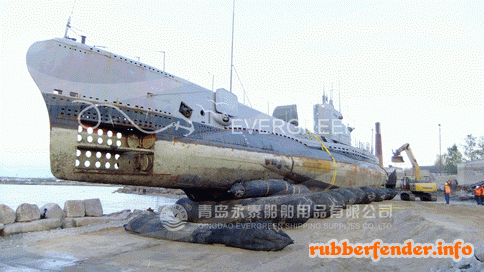Marine airbag ship launching technology is developing fast nowdays and at the same time it is required to be competent for more complicated launch projects. People who is familiar to this technology may know that to launch a ship with marine airbags it will need the vessel’s supporting blocks not higher than the airbags’ diameters. But if people have to launch a 7280 tons ship with supporting blocks’ heights range from 0.9 m to 2.1 m ,what they should do? Eversafe Marine engineering company received a
invitation from a client to help launch a 7000 tons DSV in Vietnam. That vessel named “CABALLO MARANGO” gets 143 meters total length; 22 meters molded width and 7280 tons launch weight. It is built on a plain ramp which consists of two parts: one is 70 meters long with a 3% angle;
another part is 74 meters long with a 4.5% angle. In the ramp only five meters there is a 25 cm wide concrete stripe, the left parts are filled with uncompressed debris. Supporting blocks is arranged to make vessel’s bottom parallel to the 4.5% angle ramp then the height of bottom is getting higher and higher from the knuckle of ramp. The main difficulty of this launch project is to lift up vessel to remove blocks. There are two practical factors caused the difficlty: the heights of part vessel’s bottom are bigger than the diameters of airbags, most vessel’s gravity is located on the bow which is upon the 3% angle part. Since the vessel’s gravity center fall behind the knuckle of ramp then people have to move vessel forward before the launch.
By several times discussion with shipyard, Eversafe technical teams decided to build temporary platform to enable airbags to lift up vessel. After the lifting up, vessel will be moved forward 30 meters which will make the vessel’s gravity center beyond the knuckle about 10 meters. But a subsequent problem will come up that after vessel moved its stern will get float when in high tide time. Then we have to do more detailed calculation to avoid the possible premature stern float. At last ballast water is employed to antagonize the unexpected stern buoyancy.

